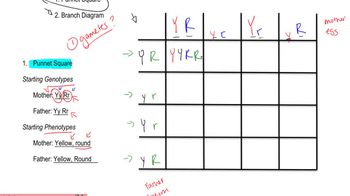The seeds in bush bean pods are each the product of an independent fertilization event. Green seed color is dominant to white seed color in bush beans. If a heterozygous plant with green seeds self-fertilizes, what is the probability that 6 seeds in a single pod of the progeny plant will consist of at least 1 white seed?
Table of contents
- 1. Introduction to Genetics51m
- 2. Mendel's Laws of Inheritance3h 37m
- 3. Extensions to Mendelian Inheritance2h 41m
- 4. Genetic Mapping and Linkage2h 28m
- 5. Genetics of Bacteria and Viruses1h 21m
- 6. Chromosomal Variation1h 48m
- 7. DNA and Chromosome Structure56m
- 8. DNA Replication1h 10m
- 9. Mitosis and Meiosis1h 34m
- 10. Transcription1h 0m
- 11. Translation58m
- 12. Gene Regulation in Prokaryotes1h 19m
- 13. Gene Regulation in Eukaryotes44m
- 14. Genetic Control of Development44m
- 15. Genomes and Genomics1h 50m
- 16. Transposable Elements47m
- 17. Mutation, Repair, and Recombination1h 6m
- 18. Molecular Genetic Tools19m
- 19. Cancer Genetics29m
- 20. Quantitative Genetics1h 26m
- 21. Population Genetics50m
- 22. Evolutionary Genetics29m
2. Mendel's Laws of Inheritance
Monohybrid Cross
Problem 26
Textbook Question
In the fruit fly Drosophila, a rudimentary wing called 'vestigial' and dark body color called 'ebony' are inherited as independently assorting genes and are recessive to their dominant counterparts full wing and gray body color. Dihybrid dominant-phenotype males and females are crossed, and 3200 progeny are produced. How many progeny flies are expected to be found in each phenotypic class?
 Verified step by step guidance
Verified step by step guidance1
Step 1: Understand the problem. The problem involves a dihybrid cross where two traits (wing type and body color) are independently assorting. The dominant traits are full wing and gray body color, while the recessive traits are vestigial wing and ebony body color. The goal is to determine the expected number of progeny in each phenotypic class out of 3200 total progeny.
Step 2: Recall the phenotypic ratio for a dihybrid cross. When two heterozygous individuals are crossed (e.g., AaBb x AaBb), the phenotypic ratio for independently assorting traits is 9:3:3:1. This means 9/16 of the progeny will show both dominant traits, 3/16 will show one dominant and one recessive trait, another 3/16 will show the other dominant and recessive trait, and 1/16 will show both recessive traits.
Step 3: Calculate the expected proportion of each phenotypic class. Multiply the total number of progeny (3200) by the fraction corresponding to each phenotypic class. For example, the number of progeny with both dominant traits (full wing and gray body) will be (9/16) * 3200. Similarly, calculate for the other classes: (3/16) * 3200 for each of the two mixed classes, and (1/16) * 3200 for the double recessive class.
Step 4: Assign the phenotypic classes to their respective proportions. The four phenotypic classes are: (1) full wing and gray body (both dominant), (2) full wing and ebony body (one dominant, one recessive), (3) vestigial wing and gray body (one recessive, one dominant), and (4) vestigial wing and ebony body (both recessive). Match the calculated proportions to these classes.
Step 5: Verify the total. Add the expected numbers for all four phenotypic classes to ensure they sum to the total progeny (3200). This step ensures that the calculations are consistent and accurate.
 Verified video answer for a similar problem:
Verified video answer for a similar problem:This video solution was recommended by our tutors as helpful for the problem above
Video duration:
1mPlay a video:
Was this helpful?
Key Concepts
Here are the essential concepts you must grasp in order to answer the question correctly.
Independent Assortment
Independent assortment is a fundamental principle of genetics stating that alleles for different traits segregate independently of one another during gamete formation. This means that the inheritance of one trait does not affect the inheritance of another, allowing for a variety of combinations in offspring. In the context of the question, the vestigial wing and ebony body color traits are inherited independently.
Recommended video:
Guided course

Gamete Genetics and Independent Assortment
Dihybrid Cross
A dihybrid cross involves two traits, each represented by two alleles, allowing for the examination of the inheritance patterns of both traits simultaneously. In this scenario, the traits are wing shape (vestigial vs. full) and body color (ebony vs. gray). The expected phenotypic ratio from a dihybrid cross of two heterozygous parents is typically 9:3:3:1, which helps predict the distribution of phenotypes in the progeny.
Recommended video:
Guided course

Punnet Square
Phenotypic Ratio
The phenotypic ratio is the relative number of offspring displaying each phenotype in a genetic cross. For a dihybrid cross of two heterozygous parents, the expected phenotypic ratio is 9:3:3:1, indicating that out of 16 total offspring, 9 will show both dominant traits, 3 will show one dominant and one recessive trait, and 1 will show both recessive traits. This ratio is crucial for calculating the expected number of progeny in each phenotypic class.
Recommended video:
Guided course

Mutations and Phenotypes
Related Videos
Related Practice
Textbook Question
444
views


